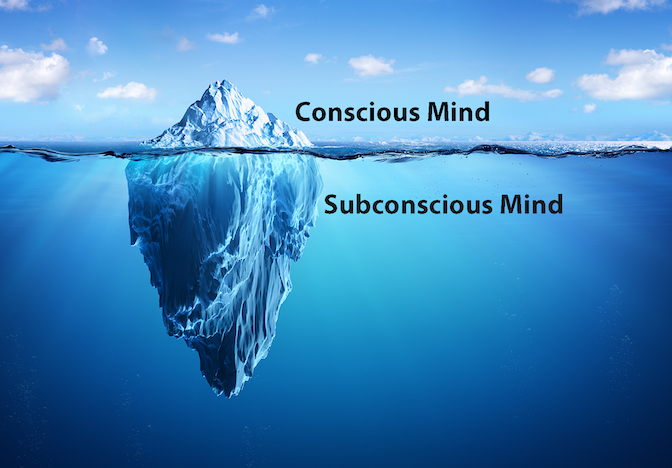Trans and Subconscious and Conscious Mechanisms
Being transgender involves human subconscious mechanisms, sometimes described as feelings from “the gut”. Studying subconscious mechanisms underneath the cerebral cortex is sometimes considered less glamorous by many investigators but they have a huge effect on behavior, particularly transgender behavior. When we think of the subconscious, Sigmund Freud often comes to mind. However, he did not contribute much to the science of the subconscious. He only sexualized and popularized ideas that already existed. The interaction between subconscious and conscious mechanisms is involved in the critical issue of whether we have free will or not. Are we deterministic robots basing our behavior on subconscious desires or is there room for conscious choice? It is a particularly important issue to transgender people who are in the closet, who must make decisions about expressing their transgender behavior and risk losing jobs, family and friends.
DEFINITIONS
I define subconscious mechanisms as those brain mechanisms that do not directly use language. Conscious mechanisms use language, that “little voice” we call thinking. When I talk about consciousness, I do not mean whether one is asleep, awake or sedated. They can be tools for reasoning and rationality. We know that many higher language mechanisms are located in the cerebral cortex, so the cortex is clearly indicated as the seat of consciousness. Julian Jaynes, a noted psychologist defined consciousness by ruling out mechanisms of perception, memory and even concept formation as being conscious. Infrahuman species are capable of most of these and humans do them without the use of consciousness. (He was one of my graduate advisors and a friend. We stayed up many nights talking about psychology over pizza and beer.) Jaynes probably contributed more to our understanding of consciousness than any other psychologist in the 20th Century. Some of his ideas were recently used as plot devices in Westworld.
Subconscious mechanisms are where the action is in terms of behavior. Subconscious mechanisms mediate immediate behavior and coordinate behaviors initiated in consciousness. Subconscious mechanisms heavily influence behavior, particularly those behaviors that require immediate attention. There are those who believe that the subconscious tricks us into believing that consciousness exists to make us feel like we are in control. I am not one of them.
SUBCONSCIOUS SYSTEMS
So, what are the mechanisms in the subconscious that are most important for transgender behavior? While there are several systems, the most important are emotion and motor behavior systems.
First, there is an extensive emotional system. This system is one of the oldest and it acts to prepare the body for future behavior. It controls parts of the nervous system that influence heart rate, blood pressure and stomach motility which we sense as emotion through our sensory systems. Being old, it is located at the bottom of the brain and down into the brainstem. There are mechanisms in this emotional system that mediate sexual arousal, hormones and female fertility cycles which are very old but there are also mechanisms that regulate hunger, thirst, body temperature. Its structure is heavily influenced by genetics and epigenetics. Much of it is beyond conscious control. For example, the nausea of sea sickness is mediated in the brain stem and cannot directly be controlled but conscious processes. We can consciously relax our muscles to reduce the anxiety effects of motion but that is about all. There are no direct neural connections between the cortex and this mechanism. In a way, that is good because there are many such low-level mechanisms and if they were under direct conscious control, our brain would have to be many times larger than it is to contain all the neural “hardware”.
Cortical mechanisms can cue the emotional system. Recognition of danger and other important situations requiring emotional responses can involve language and consciousness. You can read signs or hear speeches that provoke emotion or hear someone say “stop” or “snake!” or “watch out!” Likewise, these mechanisms can cue emotions involving gender behaviors.
The emotional system is undoubtedly involved as we begin to learn about gender. We are genetically predisposed to have particular feelings about behaviors as we learn about them as children. These include gender behaviors which we see over and over again in childhood and exhibited by grownups around you. You cannot be transgender until you know something about gender so this learning is critical. Transgender people seems to have a predisposition to react emotionally to gender behaviors in ways that are different from most people. They feel positive towards behaviors that are associated by culture with the opposite sex. They feel negative emotions towards gender behaviors that culture associates with their own sex. These feelings become consolidated in learning through the emotional system. These learnings are adapted to the gender behaviors that specific cultures identify. They are different in different geographical and historical cultures. The positive and negative feelings toward gender behaviors are summed up as feelings about cultural gender behavior categories. Transgender people come to prefer and follow a gender behavior category that is not the one they were assigned at birth according to sex assigned at birth.
The second subconscious system involved with being transgender is the motor system. The essence of being an animal is that we move around and behave, so this system is likewise to emotion as one of the oldest from an evolutionary point of view. The motor system mediates behavior. At the most primitive level in the spinal cord it responds to stimuli by producing movement. The knee jerk reaction is an example of this in which a doctor taps on a tendon in the knee that sends impulses to the spinal cord which in turn cause the knee to jerk upward. As with the emotional systems there are mechanisms beyond the control of consciousness and the knee-jerk is one of them. As one ascends the spinal cord into the brain, this system becomes more elaborate and more complicated as more subtle behaviors are mediated. This system takes up most of the brain real estate above the emotional system and has its own dedicated organ—the cerebellum that coordinates movement.
The motor system is an important means of learning about gender behavior. The motor system has a property that allows it to mirror behaviors that we see. The same neural cells (neurons) involved in mediating movement are also activated when we see other people moving and behaving. It helps us to learn new movements and behaviors. For example, dancers have talent and extensive training to use this motor system mechanism to be able to see a movement and reproduce it. When transgender people see a gender behavior that they like emotionally, say wearing a pretty dress, they may want to reproduce it.
FREUD
We often think about Freud when we think about the subconscious. Freud became famous because he sexualized and then popularized the idea of the subconscious (and himself) but his contributions towards understanding it were not scientific. He used the sexualized subconscious idea to retroactively explain behavior but his ideas could not be used to accurately predict behavior. Therefore, they were not scientific theories. He did real harm to transgender people in at least three ways. First, his non-scientific work spawned numerous psychodynamic causation “theories” (my last count was 23) which continue to pathologize transgender people to this day. For example, the goal of Rapid Onset Gender Dysphoria (ROGD) studies in 2018 was to support psychodynamic “theories” which would indicate that transgender people should undergo psychoanalytic “treatment” to “cure” them of their delusions. The ROGD cases mainly concerned teenage trans men. The cure would be based on dealing with the supposed subconscious remnants of early trauma. (In 1972, the American Medical Association declared that psychoanalysis could not cure being transgender.) The second way we were harmed is through Freud’s idea of “identity” which supported pathologization through the DSM category of “gender identity disorder”. It labeled us as diseased for over 43 years. The term is still used today to declare that transgender people are “crazy”. The third way it has harmed transgender folks is that it was used to develop ideas of “identity” politics that are used by politicians to treat us as victims in order for them to gain power. This has resulted in a backlash of hurtful laws and policies from those politicians that oppose them. Perhaps, more importantly, it is a barrier for acceptance by cisgender people.
FREE WILL
Transgender people defer their private and public transgender behavior to protect jobs, families and relationships. Is this because there is room for free will?
So, what about free will? Is our behavior determined exclusively by our subconscious mechanisms? The answer is that unless we have prepared a response consciously in advance, the subconscious will respond in cases where an immediate behavior is required. These have been described as fast thinking as opposed to slow thinking which allows more time for rationality and reason by Kahneman. There are numerous brain recording studies starting with Libet in the 1980s with EEG and later with fMRI which indicate that in situations where a short response time is required, that the subconscious will initiate behavior before we obtain conscious awareness. These studies also indicate that the person’s response can actually be determined in advance using these brain recordings.
All is not lost for free will, the short term decisions in these brain recording studies are relatively trivial. We tend to take some time to consider the big decisions in our lives like what job to take, who to marry, who to vote for. These decisions often require a lot of brain processing in which we can change our minds several times. A scientist would say that such decisions allow for feedback on alternatives. We can try various alternatives out on our brain mechanisms before making a final decision. We can use preplanning for many immediate decisions. We can take some time to consider what we might do under various circumstances such as should I kiss on the first date, if given the opportunity will I steal, should I contribute money to a particular charity and should I crossdress. Although even these decisions are sometimes overruled by subconscious impulse.
CRITICAL THINKING SKILLS
So, we do have free will for decisions if we want to use it. Consciousness allows us to use logic and our rational faculties But we have to decide to use these skills. It is important for these decisions that we hone our critical thinking skills. Carl Sagan was a proponent of critical thinking skills and developed a “baloney detection kit” of tools to evaluate, for example, scientific research studies, claims of alien UFO landings and conspiracy theories. Such tools are also good for making other types of decisions using skeptical, logical and rational thinking. Ostensibly we send people to schools and universities to learn critical thinking skills but many people think that schools and universities have been falling down on this job. Perhaps this is because schools have been taken over by post-modernist philosophies that deny the existence of facts and reality.
CONCLUSION
Scientific information about subconscious mechanisms is clearly of value to transgender people to help understand themselves. We need more of it.
Like to make a comment? Login here and use the comment area below.
Category: Transgender Science














